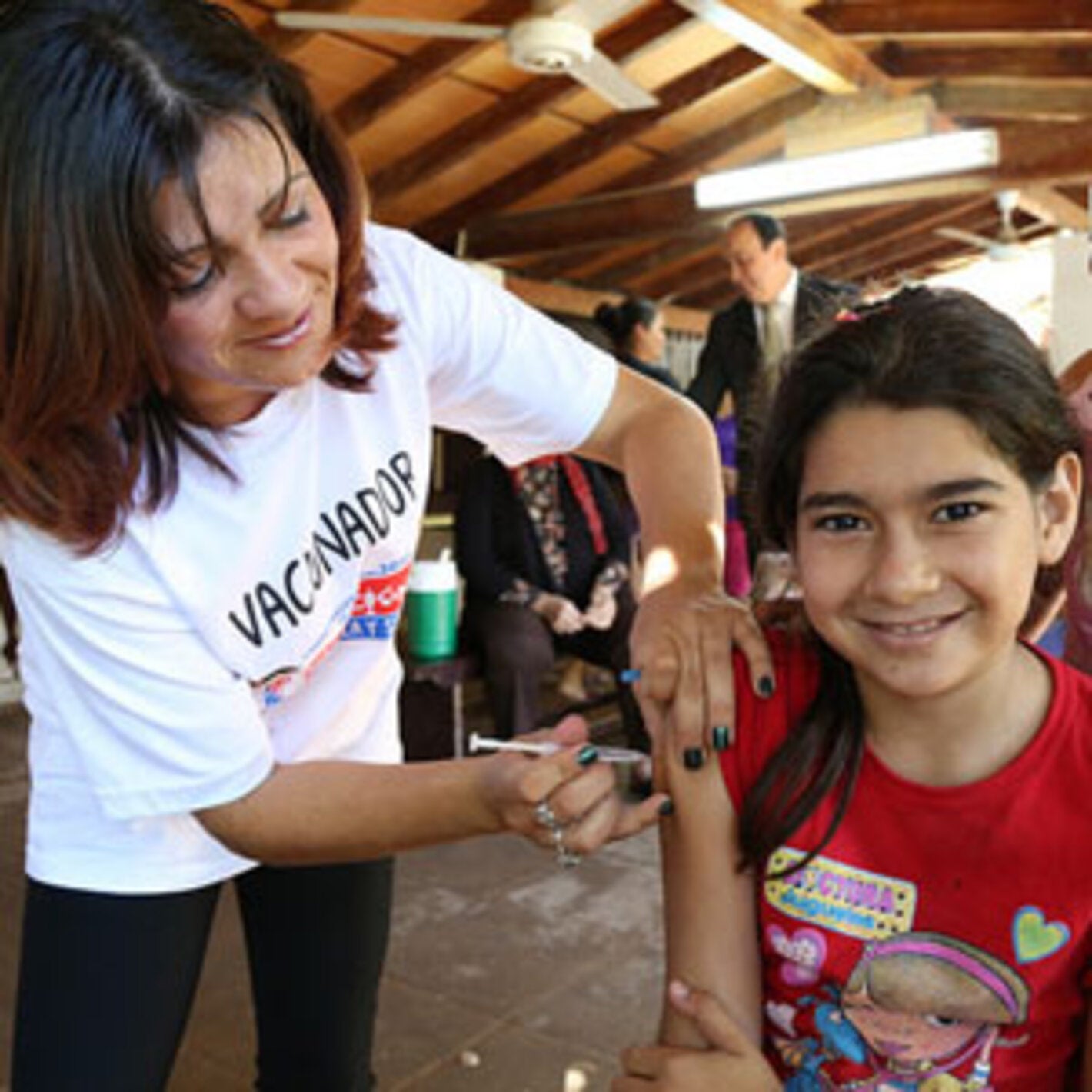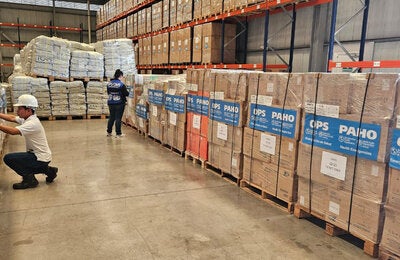
Washington, DC, April 27, 2017 (PAHO)- Since the countries of the Americas started celebrating Vaccination Week in the Americas (VWA) in 2003, this initiative, coordinated by the Pan American Health Organization (PAHO), has helped attain many achievements. Here are 15 of them.
1. The Americas as a leader in vaccination
The Region of the Americas has been a global leader in the elimination of vaccine-preventable diseases for many years. In 1971, the Americas became the first region in the world to eliminate smallpox; in 1994, the region was declared free of polio; in 2015, the Americas put an end to rubella and congenital rubella syndrome, and in 2016, the countries eliminated measles transmission. These achievements, together with high national immunization coverages, and the advances towards the elimination of neonatal tetanus and the control of diphtheria and pertussis, have positioned the Americas as a global leader in immunization.
2. 640 million people vaccinated
From the time VWA was started in 2003, more than 640 million people in the Region of the Americas have been vaccinated under the umbrella of VWA activities, against many dangerous diseases - including polio, measles, rubella, rotavirus, human papilloma virus (HPV), influenza, and yellow fever.
3. Rubella and Congenital Rubella Syndrome elimination
Endemic transmission of rubella and congenital rubella syndrome (CRS) was eliminated in the Americas in 2015, marking another leadership achievement. Although rubella is often a mild disease, when a pregnant woman is infected, it can cause miscarriage or severe birth defects, including blindness, deafness and heart defects. Mass measles and rubella (MR) vaccination campaigns that reached out to youths and adults in unconventional places - such as malls, jails, stadiums, and on public transportation - helped the Region to end rubella transmission.
4. Measles Elimination
In 2016, the Region of the Americas became the first region in the world to be declared free of endemic transmission of the measles virus. One of the most contagious diseases known to humankind, measles can cause pneumonia, brain swelling and death. The Americas worked hard to stop measles from spreading by conducting one-time catch-up campaigns in children 1-14 years old, strengthening routine immunization to reach 95% of children every year, and undertaking massive follow-up campaigns every four years to reach 95% of children with a second dose of the vaccine.
5. 25 years without polio
A massive, focused effort against polio in the Americas that began in 1985 and continued with high vaccination coverage rates and strong epidemiological surveillance led to its eradication in the Americas, with the last case of wild polio seen in 1991. In 2016, the Region celebrated 25 years of no cases of wild poliovirus. Polio causes a highly contagious disease with no cure that can cause paralysis in a matter of hours. At the global level, there are fewer cases of polio today than ever before and only one of the three types of wild poliovirus still circulates, which means that global eradication is close to being achieved.
6. Healthier populations, more savings
Evidence continues to show that vaccination is one of the safest, most cost-effective ways to prevent diseases and death. The polio vaccine has prevented 15 million cases of paralysis worldwide, and it is estimated that its eradication will result in economic savings of some $40-50 billion dollars.
7. First to introduce new vaccines
The Region of the Americas has been at the forefront in introducing new vaccines as part of routine vaccination schedules in countries since 2000. To date, 20 countries and territories in the Region have introduced the rotavirus vaccine, which protects against deadly diarrheal diseases; 34 have introduced pneumococcal vaccine, which protects against types of pneumonia, meningitis and blood infections; and at least 24 have introduced the HPV vaccine, which protects against most types of cervical cancer and genital warts.
8. The dedication of health workers to reach underserved populations
Every year, Vaccination Week in the Americas activities focus on reaching populations with limited access to health services, including indigenous populations, migrants, populations living in rural and border areas, and people living in urban fringe areas. The commitment of health workers to reach everyone has allowed these populations to receive vaccinations that protect them from potentially deadly diseases.
9. Purchase of quality vaccines at the lowest price
For more than 35 years, PAHO's Revolving Fund has made high-quality vaccines and supplies available to countries at the lowest possible price. Each year, the Revolving Fund helps the Member States of the Organization purchase more than 200 million doses of vaccines. Under an equity principle, all participating countries have access to the same products, at the lowest price, regardless of their size or economic development.
10. Pan Americanism for vaccination
The collaboration among the countries of the Region has been a key part of the success of Vaccination Week in the Americas. Although national participation in VWA is flexible depending on each country's priorities, countries often join efforts and hold binational activities along borders, in areas where access to health services and vaccination is limited. These vaccination activities have taken place over the last 15 years during Vaccination Week in border areas between the USA and Mexico; Guatemala and Belize; Argentina, Bolivia, and Paraguay; Haiti and the Dominican Republic; Suriname and French Guiana; and Peru and Bolivia.
11. Political commitment to vaccination
The countries of the Americas have continuously demonstrated their commitment to vaccination by maintaining strong Expanded Programs on Immunization (EPI) and dedicating national financial resources for vaccination. In fact, 95% of national immunization programs in the region are financed by the countries themselves, helping to ensure the long-term sustainability of the programs.
12. Vaccination as a right for the whole family.
Social mobilization and communication campaigns in Vaccination Weeks have contributed to people in the Americas recognizing their right to vaccination, resulting in a higher demand for vaccines. At the same time, more people understand that vaccines provide protection at different life stages: from birth (BCG, hepatitis b), childhood (polio, measles, mumps, rubella), adolescence and youth (HPV), adulthood (influenza), pregnancy (influenza, tetanus / diphtheria / pertussis) and the elderly (influenza and pneumococcal).
13. An opportunity for health promotion
Vaccination Week in the Americas activities are often targeted at populations who may not have regular contact with health services. They also are a great opportunity to incorporate health promotion activities. Over the years, countries of the Region have taken advantage of Vaccination Week to add such activities as screenings for diabetes and high blood pressure, and to administer deworming medicines, promote breastfeeding, HIV testing, provide dental care and demonstrate vector control activities.
14. The start of a global movement
The successful VWA experience has served as a model for other Regions of the WHO, whom established and evolved their own sister initiatives which grew into a global movement. The first region to follow suit was Europe in 2005. The Eastern Mediterranean and Africa regions began vaccination weeks in 2010, followed by the Western Pacific in 2011, and South-East Asia in 2012. In 2012, when the Americas celebrated a decade of VWA, the globe celebrated the first ever World Immunization Week (WIW), a global movement supported by the World Health Assembly.
15. Toward a healthy tomorrow
The achievements of the past 15 years have set the foundation for a healthier tomorrow. As current vaccines gain wider usage, new vaccines are being developed to protect against malaria, different types of cancers, and other chronic diseases, as well as Ebola and Zika. New technologies are also in the works to make vaccines easier to administer. All of these advances aim towards the same goal: A healthier world with the presence of fewer dangerous diseases.



